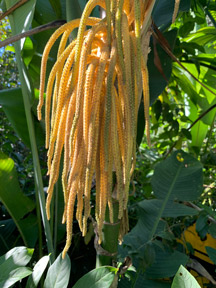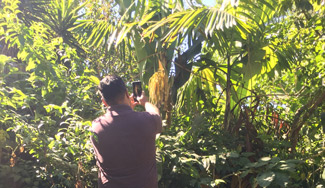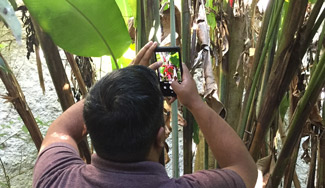Mobile smartphone camera reviews: Apple iPhone Xs compared with Google Pixel 3 XL
The photos you see here are the first stage of a long-range review. I have to head to Dubai to lecture this weekend, then back to photograph at Parque Nacional Yaxha Nakum Naranjo in the rain forests, then to lecture on Mayan iconography at Museo Popol Vuh, Universidad Francisco Marroquin. But I wanted at least to get this started with sample photos from the Apple iPhone Xs vs Google Pixel 3 XL.
Phone camera Photo results: reviews comparing Apple iPhone Xs vs Google Pixel 3 XL
Chamaedorea tepejilote, pacaya |
||

|
||
Click to enlarge image |
Click to enlarge image |
Click to enlarge image |

|

|
|
Photo by Josefina showing the Google phone in use. |
Photo by Josefina with iPhone 6 showing the |
Heliconia latispatha |
||

|
||
Click to enlarge image |
Click to enlarge image |
Click to enlarge image |

|

|
|
Photo by Josefina with iPhone 6 showing the
|
Photo by Josefina showing the Google phone in use. |
Heliconia latispatha |
||

|
||
Click to enlarge image |
Click to enlarge image |
|
Heliconia collinsiana |
||

|
||
Click to enlarge image |
Click to enlarge image |
Click to enlarge image |

|

|
|
Photo by Josefina with iPhone 6 showing the
|
Photo by Josefina showing the Google phone in use. |

|
|
Click to enlarge image |
Click to enlarge image |
As soon as we have a Sony Point-and-Shoot we will show the Benefits
Telephoto quality is what a point-and-shoot camera can provide, that a mobile phone can’t yet handle. We have a 180mm and 300mm prime lens for the Canon EOS 1DX Mark II. For the Nikon we have 200mm, 400mm, 600mm, 800mm and the special dedicated accessory for making a Nikon 1000mm (very different than a mere tele-extender).
We have tried Nikon point-and-shoot with exxxxxxtended telephoto lenses, but without a tripod they don’t compare favorably with a DSLR Nikon or Canon true NON-zoom prime telephoto lenses (no Sigma, no Tamron, nothing but pure Canon and Nikon). So we look forward to a Sony point-and-shoot Sony Cyber-shot DSC-RX100 VI or comparable.
|
FLAAR (USA) and FLAAR Mesoamerica (Guatemala) is a good place to review photography equipment. Nicholas started with a Leica in 1961; his high school thesis with these photos got him accepted at Harvard. Within a few years he was in the Mayan jungles for 12-months straight, using a medium format Rolliflex (1965). Within a year after that he was using Hasselblad; then 4x5 Linhof, then 8x10 Linhof to do photography for 18 months for a Japanese coffee table book on Maya, Olmec, Aztec, Mixtec, Zapotec art and monumental architecture (1990’s). By the end of the 35mm, medium format era (in addition to the two Linhof large format cameras), he had three Leica cameras and three Hasselblad cameras. Dr Nicholas entered the digital era when the Japanese Ministry of Education flew him to Japan for a 6-month fellowship to teach digital imaging to the staff at the Japanese national museum of Ethnology. That same year he received a $100,000 grant to “take FLAAR out of the Leica and Hasselblad and Linhof film era, into the digital era.” FLAAR was known around the world for the quality of its film-based photography of Mayan art, pyramids, temples, palaces, and ballcourt architecture, and stone stelae and other sculptures and murals. Our favorite all time camera would be a Phase One with Capture One software, but in the meantime we have enough Canon and Nikon equipment that on field trips it takes, literally, an entire pickup truck to carry all the equipment out into the rain forests of Guatemala (plus a team of additional photographers and four assistants). FLAAR welcomes other photographers, especially university students from Guatemala. Dr Nicholas was a professor at, Rollins College in Florida, and Brevard Community College then College of Technology at BGSU in Ohio and FLAAR digital imaging test and evaluation facilities at the prestigious UFM in Guatemala. |
Mobile Phone camera specs Apple iPhone Xs vs Google Pixel 3 XL
Apple iPhone XS, Dual camera set-up
12 MP, f/1.8, 26mm (wide), 1/2.55", 1.4µm, OIS, PDAF
12 MP, f/2.4, 52mm (telephoto), 1/3.4", 1.0µm, OIS, PDAF, 2x optical zoom
Google Pixel 3 XL, Single camera
12.2 MP, f/1.8, 28mm (wide), 1/2.55", 1.4µm, OIS, dual pixel PDAF
|
We thank Paulo Núñez for loaning the Google Pixel 3 XL. As soon as a Huawei Mate 20 Pro is available we will do more test photography. We thank Manfrotto and Gitzo for providing tripods. We appreciate Savage providing background paper. |
First posted January 8, 2019.